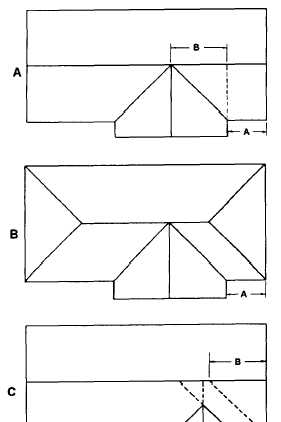tables. Let’s suppose that the common rafter unit of rise
is 8. In that case, the unit length of a valley rafter is 18.76.
The total run of the longer valley rafter between the
shorter rafter tie-in and the rafter plate is the hypotenuse
of a right triangle with the altitude and base equal to
one-half of the span of the addition. Suppose the
addition is 20 feet wide. Then, the total run is:
Figure 2-60.-Intersection ridge and valley rafter location
layout.
The locations of additional ridge and valley rafters
can be determined as indicated in figure 2-60. In an
equal-span situation (views A and B), the valley rafter
locations on the main-roof ridge lie alongside the
addition ridge location. In view A, the distance between
the end of the main-roof ridge and the addition ridge
location is equal to A plus distance B, distance B being
one-half the span of the addition. In view B, the distance
between the line length end of the main-roof ridge and
the addition ridge location is the same as distance A. In
both cases, the line length of the addition ridge is equal
to one-half the span of the addition, plus the length of
the addition sidewall rafter plate.
Figure 2-60, view C, shows an unequal-span
situation. If framing is by the long and short valley rafter
method, the distance from the end of the main-roof ridge
to the upper end of the longer valley rafter is equal to
distance A plus distance B, distance B being one-half the
span of the main roof. To determine the location of the
inboard valley rafter, first calculate the unit length of the
longer valley rafter, or obtain it from the unit length rafter
You know that the valley rafter is 18.76 units long
for every 16.97 units of run. The length of rafter for
14.14 feet of run must therefore be the value of in
the proportional equation 16.97:18.76::14.14:x, or
15.63 feet. The location mark for the inboard end of the
shorter valley rafter on the longer valley rafter, then, will
be 15.63 feet, or 15 feet 7 9/16 inches, from the heel
plumb cut line on the longer valley rafter. The length of
the additional ridge will be equal to one-half the span of
the addition, plus the length of the additional sidewall
top plate, minus a shortening allowance one-half the 45°
thickness of the longer valley rafter.
If framing is by the suspended ridge method, the
distance between the suspension point on the main-roof
and the end of the main-roof ridge is equal to distance
A plus distance C. Distance C is one-half the span of the
addition. The distance between the point where the
inboard ends of the valley rafters (both short in this
method of framing) tie into the addition ridge and the
outboard end of the ridge is equal to one-half the span
of the addition, plus the length of the additional ridge
(which is equal to one-half of the span of the main roof),
plus the length of the addition sidewall rafter plate.
Roof Frame Erection
Roof framing should be done from a scaffold with
planking not less than 4 feet below the level of the
main-roof ridge. The usual type of roof scaffold consists
of diagonally braced two-legged horses, spaced about
10 feet apart and extending the full length of the ridge.
If the building has an addition, as much as possible
of the main roof is framed before the addition framing
is started. Cripples and jack rafters are usually left out
until after the headers, hip rafters, valley rafters, and
ridges to which they will be framed have been installed.
For a gable roof, the two pairs of gable-end rafters and
the ridge are usually erected first.
Two crewmembers, one at each end of the scaffold,
hold the ridge in position. Another crewmember sets the
gable-end rafters in place and toenails them at the rafter
plate with 8d nails, one on each side of a rafter. Before
we proceed any further, see table 2-1 as to the type and
2-36


